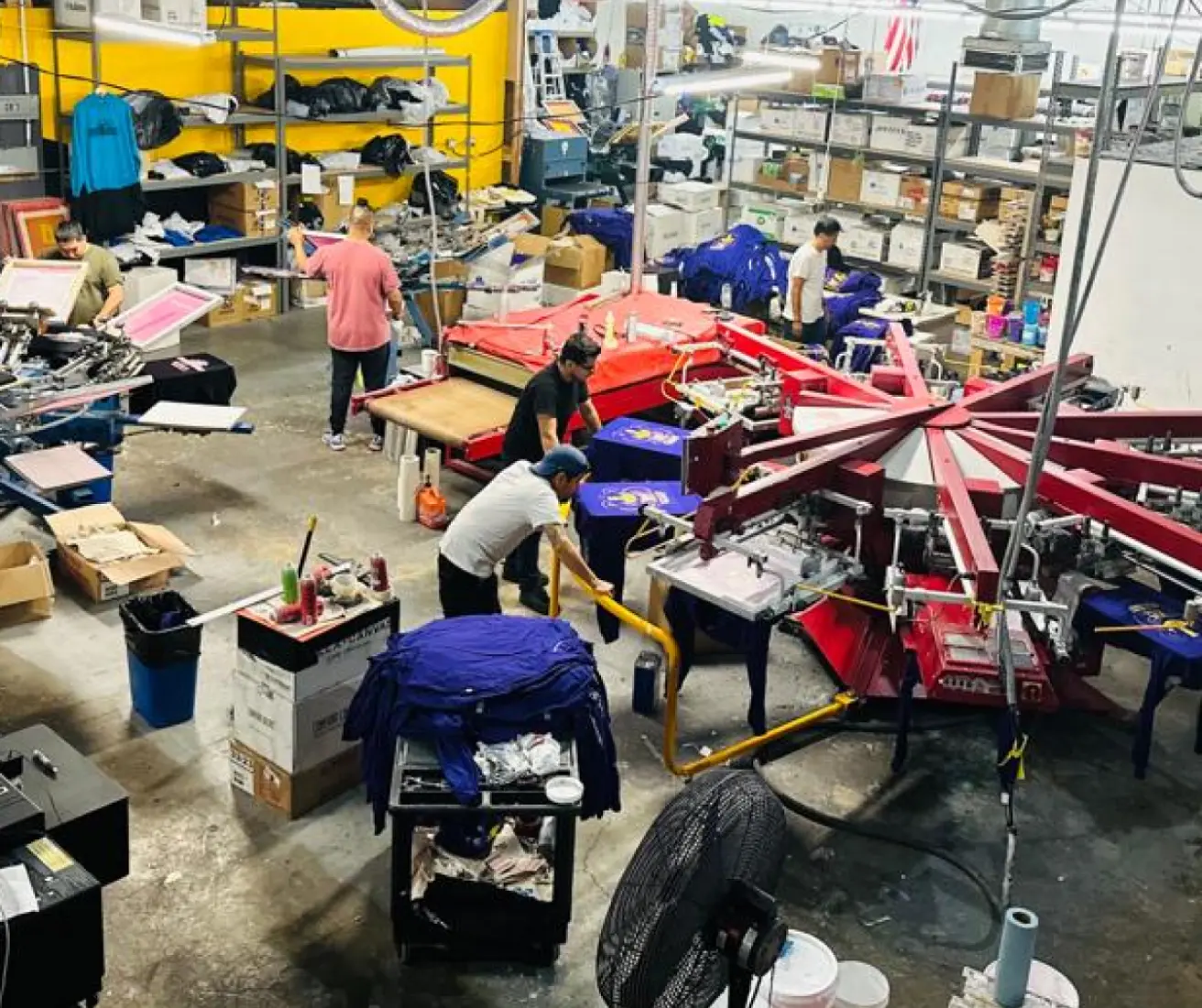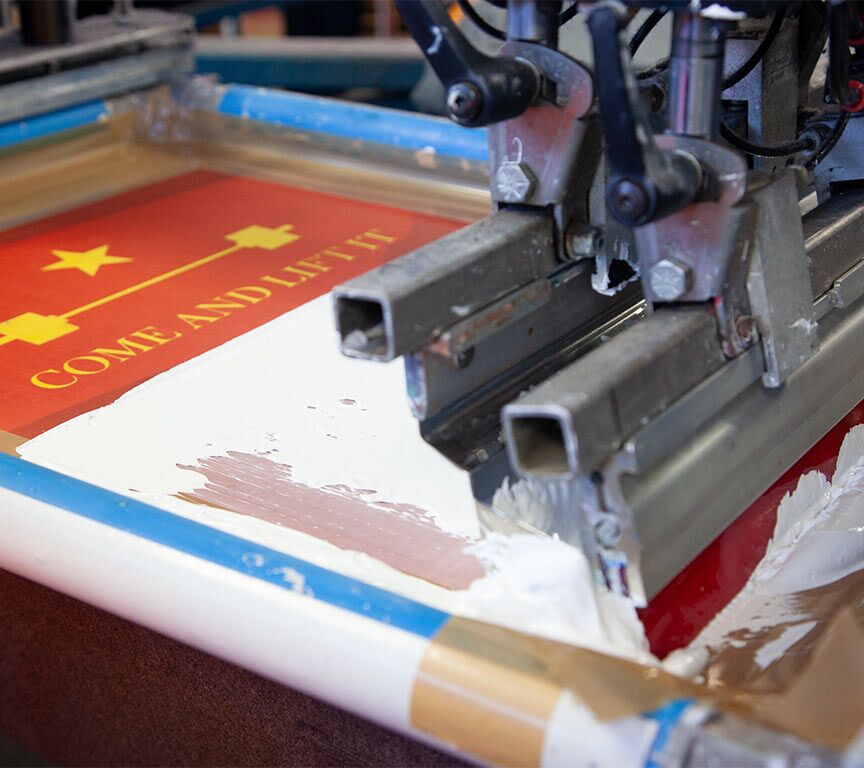Vintage Style Silk Screen Printing for Retro Fashion
Vintage Style Silk Screen Printing for Retro Fashion
Blog Article
Screen Printing Uncovered: Whatever You Required to Find Out About T-Shirt and Garment Printing Strategies
Screen printing is an interesting approach that incorporates art with technique, offering countless possibilities for creativity. Prepared to discover the vital aspects that make display publishing an art form?
The Basics of Screen Printing: How It Functions
When you plunge right into display printing, you'll discover it's both an art and a scientific research. At its core, display printing entails producing a pattern, or screen, that permits ink to pass via just in particular areas.
Setting the display over the textile, then utilize a squeegee to push ink through the screen onto the garment. Each step is vital, and understanding them will certainly boost your screen printing abilities, changing simple garments into unique, expressive items.
Kinds of Screen Printing Strategies
As soon as you grasp the essentials of display printing, it's time to check out the various methods that can raise your layouts. One popular approach is traditional screen printing, where ink is pressed with a stenciled screen.
If you're aiming for great details, take into consideration discharge printing. This method removes dye from the textile, leaving a soft, vintage appearance. Another alternative is plastisol printing, understood for its longevity and brilliant colors, making it a favored for several brands. Ultimately, try out halftone printing to produce slope results and intricate designs. Each technique has its distinct beauty, so don't hesitate to try them out to locate what matches your style best!
Crucial Tools for Screen Printing
To achieve stunning outcomes in display printing, having the appropriate tools is fundamental. First, you'll need a strong screen printing frame, which holds the mesh that transfers your layout onto the garment. Next, spend in premium squeegees; these are essential for applying ink equally throughout the display. You'll also call for an excellent exposure system to create your displays, along with a washout booth for cleansing them after usage. A reliable warmth resource, like a conveyor clothes dryer or heat press, is essential for treating your prints to ensure durability. Do not neglect a proper work area, geared up with tables and storage for your materials. Protective gear, such as masks and handwear covers, will keep you safe from chemicals and inks. With the right tools, you'll be well on your way to generating professional-quality prints.
Picking the Right Inks and Materials
When picking inks and materials for display printing, you require to think about the kind of ink that functions ideal for your project. Think of textile compatibility to assure your layouts look last and terrific lengthy. Explore green ink choices to make your printing procedure more lasting.
Kinds Of Display Inks
Selecting the ideal screen ink is vital for attaining vibrant, durable prints that satisfy your project's needs. There are a number of types of display inks to analyze. Specialized inks, such as metallic or glow-in-the-dark, can include distinct results to your styles.

Fabric Compatibility Considerations
Understanding textile compatibility is vital for accomplishing high-grade screen prints, specifically because different products react distinctly to numerous inks. Always examine your inks on example fabric to assure they adhere effectively and preserve shade integrity. Furthermore, keep in mind that material weight and structure can affect the final end result, so selecting the appropriate ink and product combination is important for your job's success.
Eco-Friendly Ink Options
Environment-friendly inks are becoming a popular selection for screen printers that wish to lessen their ecological effect while keeping high quality. When picking inks, consider water-based inks, which are much less hazardous and easier to cleanse up contrasted to traditional solvents. These inks bond well with materials, supplying vibrant results without hazardous chemicals. You may additionally check out eco-solvent inks that utilize less unpredictable organic substances (VOCs), making them a much safer alternative for both your health and wellness and the earth.
Furthermore, seek inks made from renewable energies, such as soy or vegetable-based options. By selecting the ideal inks and materials, you'll not just create sensational layouts but additionally add to an extra sustainable printing process. Make the button, and your prints will show your dedication to the setting!
Preparing Your Layout for Display Printing

File Style Requirements
To guarantee your design looks vivid and sharp on fabric, you'll need to pay attention to submit format demands for display printing. Start with vector data like AI or EPS, as they can be scaled without losing high quality. If you use raster images, choose for high-resolution data, such as TIFF or PNG, ideally at 300 DPI. Prevent making use of JPEGs, as they can shed clarity when resized. Make certain your layout has a transparent background to stop unwanted white sides on your prints. Ultimately, maintain color modes in mind; CMYK is conventional for display printing, so convert your RGB makes appropriately. By complying with these guidelines, you'll set your art work up for a successful print.
Shade Splitting Up Strategies
Shade splitting up is an important action in preparing your design for screen printing, and mastering it can substantially enhance your print high quality. You'll need to damage your style right into specific shades, as each color needs a separate display throughout printing. This precision not just assures exact go color representation however also simplifies the printing procedure.
Resolution and Dimension
Accomplishing the very best cause display printing starts with ensuring your design has the ideal resolution and dimension. Preferably, your artwork should go to the very least 300 DPI (dots webpage per inch) for sharp, clear prints. Your last item may look pixelated and amateur. if you make use of lower resolution.
When it concerns dimension, think about the dimensions of your print location. Design your art work to match the final print size, ideally developing it in the real measurements you'll be publishing. In this manner, you'll avoid any kind of unexpected scaling concerns.
Always check your layout in both vector and raster layouts. Vector graphics can be scaled without shedding high quality, making them perfect for screen printing. Preparing properly will guarantee your design looks fantastic on every garment!
Step-by-Step Screen Printing Refine
Screen printing is a dynamic procedure that enables you to create dynamic layouts on numerous surfaces. To get begun, you'll require a screen, solution, and your selected ink. Prepare your screen by cleansing it extensively. Next, use the emulsion uniformly and let it dry in a dark area. Once completely dry, expose your display to light with your layout positioned on it, which will set the solution where the light hits, creating a pattern - screen printing kit.
After rinsing the unexposed solution, your display prepares. Establish it up on your printing surface area and align your garment underneath it. Pour ink onto the screen and use a squeegee to press the ink through the stencil onto the fabric. Lift the display very carefully and let the print completely dry. Heal here the ink making use of heat to guarantee resilience. That's it! You've effectively screen published your design.
Tips for Successful Screen Printing Projects
While you're diving right into your display printing jobs, keep in mind that prep work is essential to success. Beginning by gathering all your materials-- inks, garments, mops, and displays. A tidy workspace assists prevent undesirable mistakes, so tidy up prior to you begin.
Following, verify your artwork is high-resolution and effectively sized for your garment. Examine your screen for correct exposure and tidy it extensively to stay clear of spots. When blending your inks, comply with the maker's standards to attain the best uniformity.
Throughout printing, apply also pressure with your squeegee for constant results. Don't rush; take your time to verify each print satisfies your standards. After printing, let your garments completely dry totally prior to handling or packaging them.
Finally, constantly keep a sample of your benefit future reference. In this manner, you can examine your development and boost your methods over time. Happy printing!

Often Asked Inquiries
For how long Does It Require To Set up a Display Printing Work?
Establishing up a screen printing job generally takes around thirty minutes to an hour. You'll prepare the displays, mix inks, and adjust journalism. The time varies based upon complexity and experience, so remain arranged!
Can I Print on Different Material Types Utilizing the Very Same Technique?
Yes, you can print on different material types utilizing the exact same technique, however you'll require to change your settings and inks. Some textiles soak up ink in a different way, so trying out assurances the most effective outcomes for each product.
What Prevail Blunders to Stay Clear Of in Display Printing?
When screen printing, stay clear of common blunders like using the incorrect ink, neglecting correct exposure times, or skipping pre-press checks. Constantly test your configuration and keep tidy screens to guarantee high quality results each time.
Exactly How Can I Appropriately Tidy and Preserve My Screen Printing Tools?
To effectively clean and keep your display printing equipment, you must consistently clean screens with appropriate solvents, check squeegees for wear, and assure all devices are saved completely dry and dust-free. Uniformity enhances and avoids expensive repairs performance.
Is Display Printing Eco-friendly Compared to Other Methods?
Screen printing can be much more eco-friendly than other techniques, especially if you use eco-conscious products and water-based inks. By picking sustainable materials and techniques, you decrease waste and decrease your impact on the planet.
Display Printing Uncovered: Every Little Thing You Required to Know About T-Shirt and Garment Printing Strategies
At its core, display printing involves developing a pattern, or display, that allows ink to pass with just in certain locations. Placement the display over the textile, after that make use of a squeegee to press ink via the screen onto the garment. One preferred approach is traditional screen printing, where ink is pushed via a stenciled screen.When picking inks and materials for display printing, you need to take right into account the type of ink that works ideal for your job.
Report this page